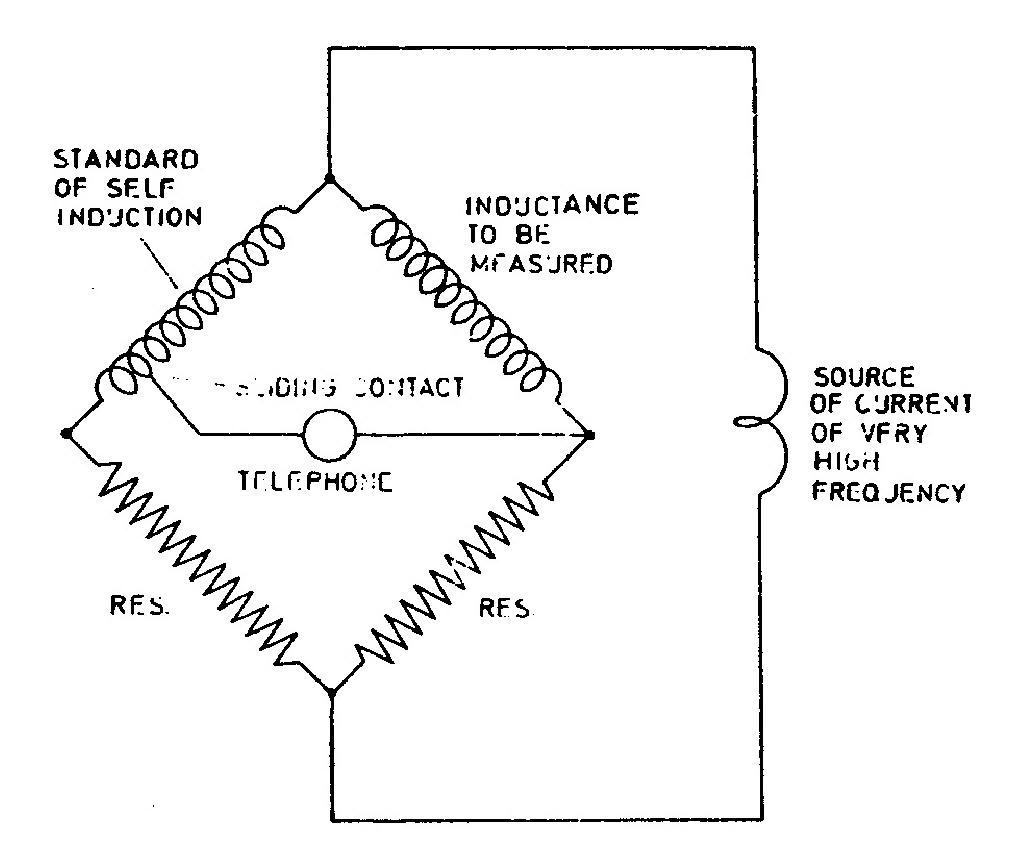
Nikola Tesla Books
L = ℼ[ 4A (loge $! {8 \, A \over a} $! - 2) + 2a (loge $! {8 \, A \over a} $! - $! {5 \over 4} $!) - $! {a^2 \over 16 \, A} $! ( 2 loge $! {8 \, A \over a} $! + 19)]
= ℼ ( 488 x 4.875735 + 2 x 5.625735 - 1/1952 x 32.75) =
= ℼ ( 2379.3600 + 11.2515 - small fraction)
= ℼ x 2390.6115 = 3.1416 x 2390.6115 L = 7210.345 cm.
this is a trifle more with ends close enough 8,000 cm.
Colorado Springs
June 8, 1899
Method and apparatus for determining self-inductances, also capacities, particularly suitable for determining small inductances.
Since resistance can be neglected when the frequency of the currents is high the inductances can be easily compared in the following way:
A standard of self-induction is provided with a sliding contact so that any number of turns can be inserted. Two resistances, suitable for the source of high frequency current and the inductance to be measured, are connected in the manner of a bridge. The two opposite points, one movable, are connected through a telephone. When no sound is heard then we have the two inductances - that is, the one to be measured, and that part of the standard which corresponds to equilibrium or silence in the telephone-practically equal if the quantities are suitably chosen. By determining inductances capacities may from these be easily measured. It is possible that the high frequency source might be dispensed with and a very sudden discharge of a condenser passed through instead. The auxiliary resistance should be so determined that the resistances in the two parts through which the current divides are equal or nearly so.
31
June 7
Descriptions of the high-frequency transformer are to be found in Tesla's publications and patents from 1891 onwards(15, 4), but he did not patent it until 1897(26). The invention protected by this patent is “A transformer for developing or converting currents of high potential, comprising a primary and secondary coil, one terminal of the secondary being electrically connected with the primary, and with earth when the transformer is in use, as set forth”. It in particular protects the spiral form of the secondary, and a conical form is also mentioned. For ordinary uses a cylindrical secondary divided into two parts is proposed. A new feature is the specification that the length of the secondary should be “approximately one quarter of the wavelength of the electrical disturbance in the secondary circuit, based on the velocity of propagation of the electrical disturbance through the coil itself”, or, in general, “so that at one terminal the potential would be zero and at the other maximum”.
June 7
Already in 1891 a description of a high frequency transformer is mentioned in Tesla's works and patents(4,15), but he patented it as late as 1897(16). In this patent the discovery of ".... transformer for production or conversion of high voltage currents which consists of primary and secondary coil with one secondary terminal electrically connected to primary, and with grounding when the transformer is used as mentioned...". The secondary in the shape of a spiral is particularly protected, and a cone shape is mentioned as well. For the usual applications he suggest the cylindrical secondary divided into two parts. New information is that the secondary has to have the length of approximately ¼ wavelength determined on the basis of phenomenon propagation speed through the secondary or generally such length that the voltage at the open secondary terminal is maximum.
The primary coil of Tesla'a high frequency transformer almost always has one to two turns. Even with such a small number of turns the primary coil inductances are sufficiently large regarding the dimensions of these coils. For example, in his patent - "Electrical Energy Transmission System"(13) the mentioned diameter of primary coil amounts to approximately 244 cm, and its inductance is approximately 8000 cms. He decided to use an even larger coil, which can be seen on the basis of data (radius 762 cm!).
In his note, Tesla does not talk about work on the laboratory construction and what he notes are the ideas and the data necessary for the experimentation. So, for example, now he describes the measurement of inductance by means of a balanced bridge, but he doesn't give the equation of the balance, and consequently some claims (and schematic) could not be proven with assurance.


